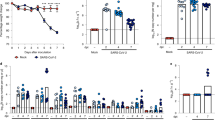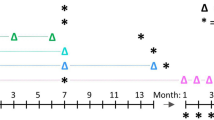Abstract
Patients with cystic fibrosis develop lung disease after birth, therefore CFTR gene replacement therapy should be most efficacious in the neonatal period prior to the onset of pulmonary damage. An adeno-associated virus (AAV) vector, SA306 (Flotte TR et al Proc Natl Acad Sci USA 1993; 90: 10613–10617), which contains the AAV inverted terminal repeats flanking the human CFTR cDNA linked to an amino-terminal epitope tag, was used to transduce a human CFTR fusion protein into neonatal New Zealand white rabbits. Vector inocula of 1 × 105 to 5 × 1010 particles were given by intratracheal instillation on day 3 of life and the rabbit lungs were studied at 3 or 4 days, 2–6 weeks, or 6 months after infection; the 2–6 week time-point corresponds to the completion of the alveolar phase of lagomorph lung development. Vector DNA was detected by an in situ polymerase chain reaction (PCR) using vector- specific primers at up to 6 weeks after inoculation. Human CFTR mRNA was detected by Northern analysis at up to 2 weeks after vector inoculation, and by a reverse transcriptase PCR assay at up to 3 weeks after infection. Epithelial expression of the human CFTR fusion protein was detected using antisera to both the human CFTR R domain and the amino-terminal epitope at up to 6 weeks after vector inoculation. Vector DNA, mRNA, or human CFTR immunoreactivity were not observed at the 6 month time-point. Rabbits infected with SA306 were clinically indistinguishable from their uninfected litter mates. These data indicate that CFTR gene transduction using an AAV vector is feasible in the neonatal rabbit, and that expression of vector-derived CFTR persists throughout the alveolar phase of lung development. The apparent lack of vector persistence after the alveolar phase may reflect dilution of transduced cells by further lung growth or a lack of transduction of pulmonary epithelial stem cells.
This is a preview of subscription content, access via your institution
Access options
Subscribe to this journal
Receive 12 print issues and online access
$259.00 per year
only $21.58 per issue
Buy this article
- Purchase on Springer Link
- Instant access to full article PDF
Prices may be subject to local taxes which are calculated during checkout
Similar content being viewed by others
Author information
Authors and Affiliations
Rights and permissions
About this article
Cite this article
Rubenstein, R., McVeigh, U., Flotte, T. et al. CFTR gene transduction in neonatal rabbits using anadeno-associated virus (AAV) vector. Gene Ther 4, 384–392 (1997). https://doi.org/10.1038/sj.gt.3300417
Received:
Accepted:
Issue Date:
DOI: https://doi.org/10.1038/sj.gt.3300417
Keywords
This article is cited by
-
Identification of liver-specific enhancer–promoter activity in the 3′ untranslated region of the wild-type AAV2 genome
Nature Genetics (2017)
-
Tailoring the AAV vector capsid for gene therapy
Gene Therapy (2009)
-
Clinical gene therapy using recombinant adeno-associated virus vectors
Gene Therapy (2008)
-
Delivery Systems for Pulmonary Gene Therapy
American Journal of Respiratory Medicine (2002)
-
Current Status of Gene Therapy for Cystic Fibrosis Pulmonary Disease
American Journal of Respiratory Medicine (2002)



